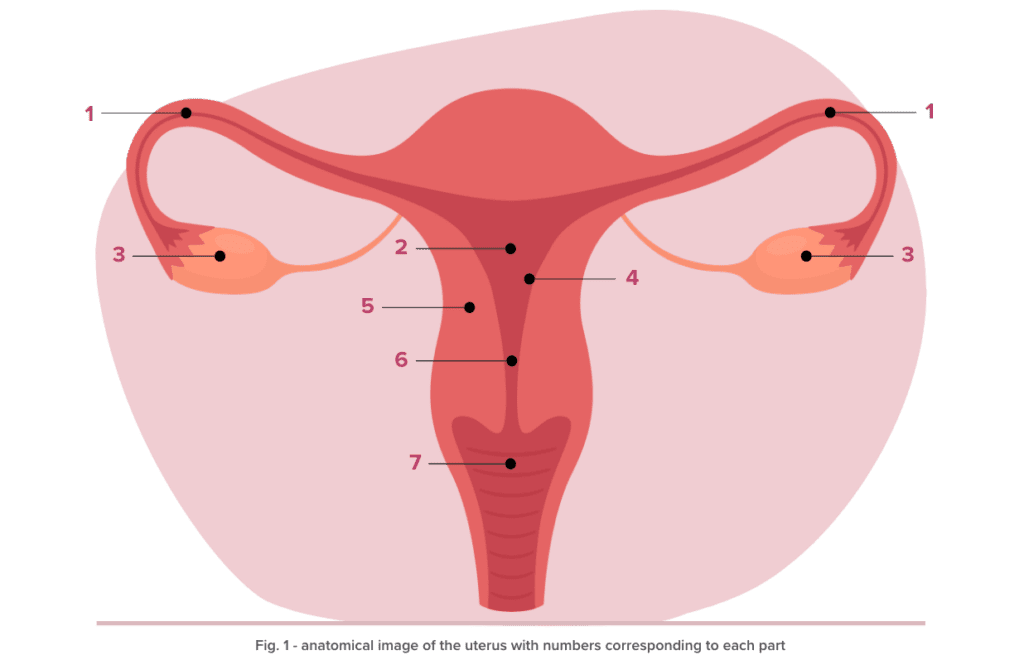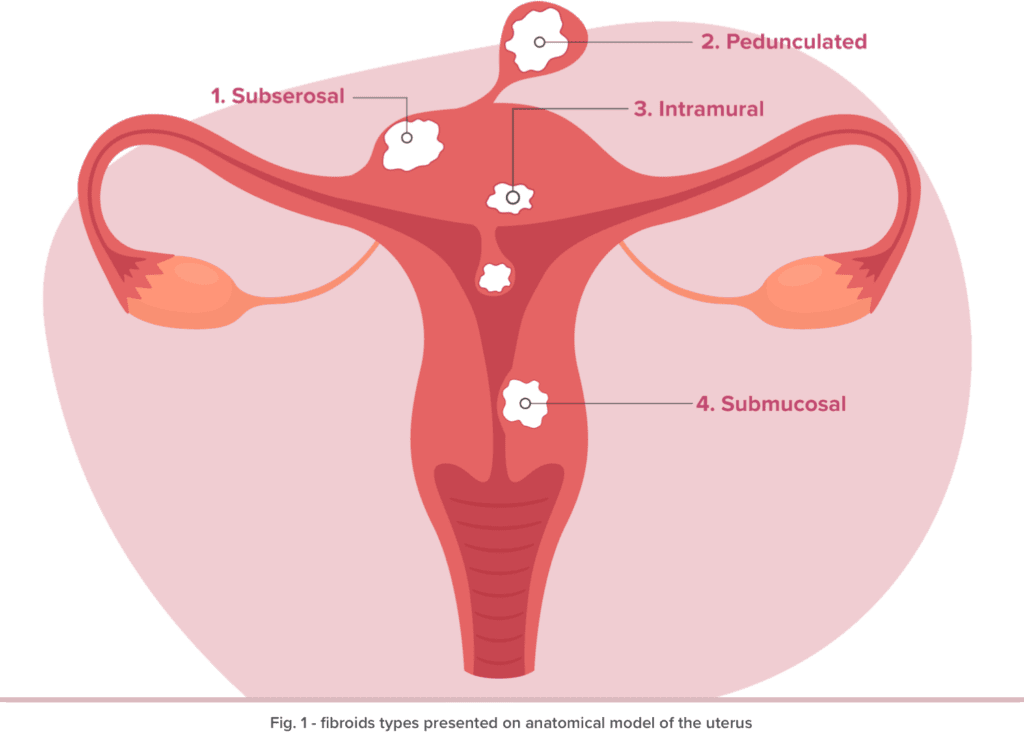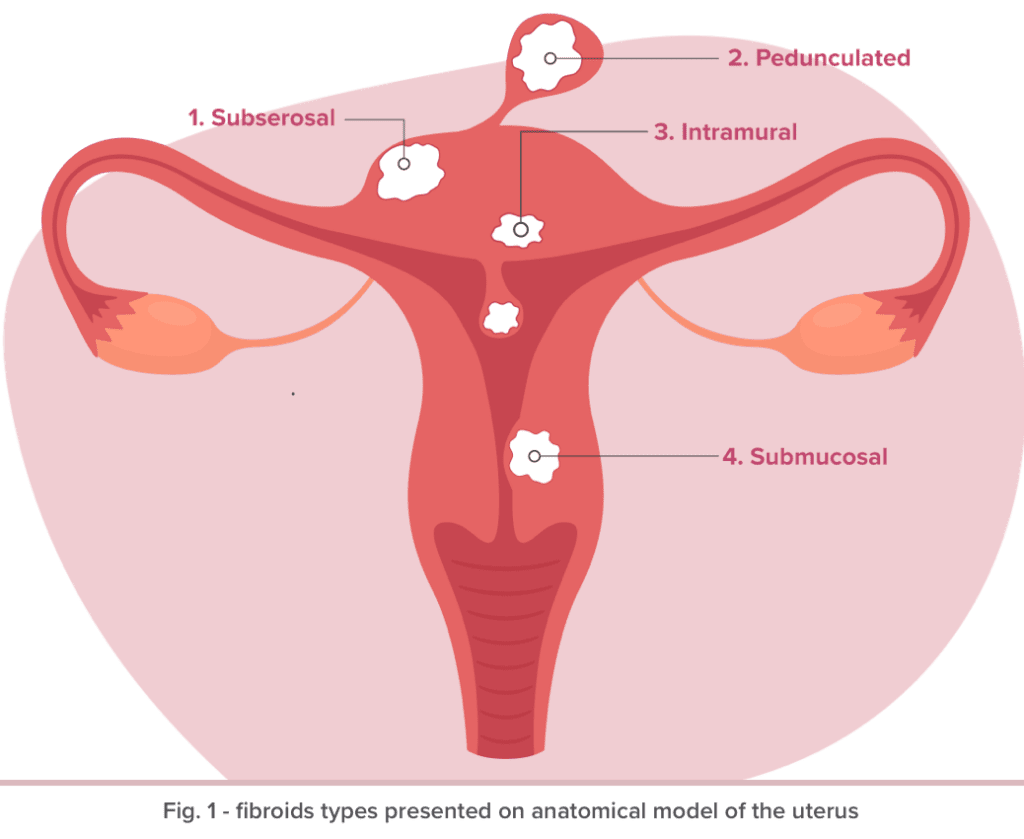Uterine fibroids:
what are they?
Uterine fibroids:
what are they?
Trying to figure out what’s going on with your body, but not sure what’s even in there? You’ve come to the right place.
Get to know your uterus
First things first. To know a fibroid, you need to know where they grow.

1. Fallopian Tube – one of two tubes along which eggs travel from the ovaries to the uterus
2. Uterine cavity – the space inside the uterus (better known as the womb)
3. Ovary – reproductive organ in which ova or eggs are produced
4. Endometrium – the mucous membrane lining the uterus; it thickens during the menstrual cycle to prepare for possible implantation of an embryo
5. Myometrium – the muscular outer layer of the uterus
6. Cervix – the lower, narrow end of the uterus that connects the uterus to the vagina
7. Vagina – the elastic, muscular part of the female genital tract
Fibroid facts and stats


will develop fibroids sometime during their childbearing years


is the average time that women with fibroids wait to seek treatment


know that a hysterectomy is not the only way to treat uterine fibroids
What are fibroids?
Fibroids defined
Fibroids are noncancerous tumors that grow in the smooth muscle cells of the uterus, made up of the same muscular tissue of the uterus. They start to grow when a cell goes rogue and becomes a fibroid cell rather than a uterine Cell. That cell replicates over and over and forms a fibroid tumor, which can grow fast or slow or even shrink over time.
Where do fibroids come from?
The cause of fibroids isn’t well understood. Risk factors include but are not limited to age, race, obesity, and family history of uterine fibroids.
Are fibroids common?
Up to 77% of women will develop fibroids sometime during their childbearing years.1
What do fibroids do?
Symptoms
- Heavy and painful or prolonged periods
- Stomach, lower back and pelvic pain
- Anemia
- Stomach protrusion
- G.I. issues like gas and constipation
- Infertility and pregnancy loss
- Painful sex
- Frequent urination
Types and sizes of fibroids
Some are big, some are small, some women have a lot, some have just one.
Fibroids are classified by where they are in the uterus, and are often expressed by diameter, in centimeters. They can also be expressed in number of weeks pregnant — comparing the size of the uterus and fibroids to the size of a uterus and fetus.
Fibroid size comparison
Fibroids can range in size from a sweet pea (0.5 cm) to a watermelon (50 cm). At the size of a sweet pea, a fibroid equates to about 6 weeks pregnant, while a watermelon is about 40 weeks — a full term pregnancy!


Fibroids classified
Doctors classify fibroids by where they are in the uterus, either within the uterine wall, in the uterine cavity, or bulging outside the uterus.




1. Subserosal* – On the outer wall of the uterus; can cause bulk or pressure symptoms
2. Pedunculated – Grow on a thin stalk (less common)
3. Intramural* – Within the muscular walls of the uterus; can cause bulk or pressure symptoms
4. Submucosal* – Found inside the body or abutting the uterine cavity; can cause heavy bleeding (least common)
*Fibroid types that can be treated with Hologic’s Acessa procedure
Fighting fibroids
Historically, watchful waiting, medication, and hysterectomies were the only solution for treating fibroids. But that was then. Today, there are treatment options that are proactive and far less invasive than removing your uterus. Talk to your doctor about which options could be right for you.


The recovery times listed are not from a single source comparing recovery times. The data listed comes from a variety of sources including clinical studies and recovery guidance provided by major medical institutions.
For hysteroscopic myomectomy: the recovery time is based on estimates provided by Mount Sinai health system in NY and the guidance they offer to patients based on their clinical experience.
For laparoscopic radiofrequency ablation of fibroids: the recovery time is based on the average reported time it took patients to return to work in the IDE study for the Acessa system.
For uterine artery embolization: the recovery time is based on a multi-center prospective single-arm clinical treatment trial that evaluated tolerance, hospital stay, and recovery after uterine artery embolization for fibroids
For myomectomy: the recovery time is based on guidance offered by the Cleveland Clinic health system and includes guidance that recovery time varies based on the surgical approach and the individual patient.
For hysterectomy: the recovery time is based on a single randomized control trial comparing short-term outcomes of different approaches to hysterectomy.
Heavy periods
Heavy periods, or abnormal uterine bleeding (AUB), are super common. It’s often caused by…you guessed it, fibroids! But it could be related to other structural and non-structural (conditions as well.
Structural causes of AUB
May include:
- Polyps
- Fibroids
- Adenomyosis
- Malignancies
Non-structural causes of AUB
May include:
- Coagulopathy
- Ovulatory disorders
- Endometrial disorders
- Thyroid disorders
Get to know a little more about your U, learn about AUB and heavy periods, and don’t forget to ask your doctor about other potential causes of your symptoms.
Important Safety Information
The Acessa ProVu system is intended to identify and shrink symptomatic uterine fibroids. The Acessa ProVu system is used by trained physicians during laparoscopic surgery under general anesthesia. Rare but serious risks of this procedure include, but are not limited to, infection, internal injury, blood loss and complications related to laparoscopic surgery and/or general anesthesia. This procedure is not recommended for women who are planning future pregnancy. This information is not medical advice. Please discuss the risks and benefits with your doctor to find out if the Acessa procedure may be right for you.
MyoSure tissue removal system is intended to remove unwanted tissue from the uterus. During a MyoSure procedure, a trained gynecologist inserts the MyoSure device through your vagina and then removes the unwanted tissue from inside the uterus. Use of the MyoSure system is not appropriate for patients who are or may be pregnant, or have signs or symptoms of a pelvic infection, cervical cancer, or previously diagnosed uterine cancer. As with any surgical procedure, there are potential risks including but not limited to internal injury, excessive bleeding, and complications related to anesthesia. Temporary side effects may include cramping, bleeding, fever, and nausea. This information is not medical advice. Please discuss the risks and benefits with your doctor to find out if the MyoSure procedure may be right for you.
References:
1. Johns Hopkins. Fibroids. https://www.hopkinsmedicine.org/health/condiJons-and-diseases/uterine-fibroids. Accessed February 20, 2019
2. Borah, Bijan J. et al. The impact of uterine leiomyomas: a naJonal survey of affected women, American Journal of Obstetrics & Gynecology, October 2013, Volume 209, Issue 4, 319.e1—319.e20. Wise LA, Laughlin-Tommaso SK. Clin Obstet Gynecol. 2016;59(1):2-24. Alexander AL, et al. Obstet Gynecol.2019;133(1):6-12
3. This survey was conducted online within the United States by The Harris Poll on behalf of Hologic between May 10-12, 2022 among 997 female adults ages 18+, among whom 815 are females ages 30+.
4.“Hysteroscopy.” Mount Sinai Health System, www.mountsinai.org/health-library/surgery/hysteroscopy. Accessed 21 Sept. 2023.
5. Chudnoff SG, Berman J, Levine DJ, Harris M, Guido RS, Banks E. SG Chudnoff, et al. Outpatient Procedure for the Treatment and Relief of Symptomatic Uterine Myomas. Obstetrics and Gynecology, 2013;121(5):1075–82. 8
6. Pron G;Mocarski E;Bennett J;Vilos G;Common A;Zaidi M;Sniderman K;Asch M;Kozak R;Simons M;Tran C;Kachura J; ; “Tolerance, Hospital Stay, and Recovery after Uterine Artery Embolization for Fibroids: The Ontario Uterine Fibroid Embolization Trial.” Journal of Vascular and Interventional Radiology : JVIR, U.S. National Library of Medicine, pubmed.ncbi.nlm.nih.gov/14551270/. Accessed 31 Aug. 2023.
7. “Treatments & Procedures.” Cleveland Clinic, my.clevelandclinic.org/health/treatments q=endometrial+ablation&dFR%5Btype%5D%5B0%5D=Treatments. Accessed 21 Sept.
2023.
8. Professional, Cleveland Clinic medical. “Myomectomy: Purpose, Procedure, Risks, Results & Recovery.” Cleveland Clinic, my.clevelandclinic.org/health/treatments/15448-myomectomy#:~:text=You%20can%20expect%20some%20pain,take%20up%20to%20six%20weeks. Accessed 8 Sept. 2023.